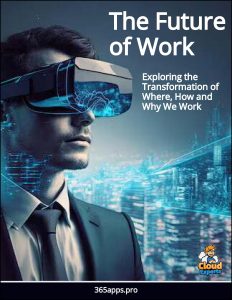Architecture for the New Future of Work
The rapidly-changing way in how work is being performed strengthens the importance for corporate decision makers to adapt and stay competitive in today’s economy.
 Microsoft’s Ai and collaboration innovations are underpinned by insights from Microsoft Research, detailed in their report: The New Future of Work.
Microsoft’s Ai and collaboration innovations are underpinned by insights from Microsoft Research, detailed in their report: The New Future of Work.
This is an initiative comprising Microsoft researchers, product leaders, and policy makers dedicated to creating solutions for a future of work that is meaningful, productive, and equitable.
They describe how Covid-19 forced a reevaluation of what work is, and where it is conducted, and the research has focused on two major trends of change in office working: Remote, hybrid working and Artificial Intelligence.
The New World of Work
The rapidly-changing way in how work is being performed strengthens the importance for corporate decision makers to adapt and stay competitive in today’s economy.
Ignoring the change in work poses a threat to an organization’s future performance, while the right measures can lead to new opportunities. An organization’s culture is a key enabler for change (McKinsey & Company, 2021) and it must support virtual teams.
Employees should be encouraged to work collaboratively, even when geographically dispersed. Collaboration trends in our digital experiences show that interactions with our close-knit network have strengthened, while our interactions with distant networks have diminished with the move to remote work.
To enable remote work, preventing digital fatigue and eliminating repetitive tasks by implementing digital automation is becoming critical. Intent is needed to define a company’s automation strategy—focusing on high-value automation opportunities, redefining job description and training needs, and setting up the right governance for the implementation of automation. Successful implementation will require strong involvement from both business and IT.
They identified that an organization’s culture is a key enabler for change (McKinsey & Company, 2021) and it must support virtual teams, where employees should be encouraged to work collaboratively, even when geographically dispersed. Collaboration trends in our digital experiences show that interactions with our close-knit network have strengthened, while our interactions with distant networks have diminished with the move to remote work.
Therefore to enable remote work, preventing digital fatigue and eliminating repetitive tasks by implementing digital automation is becoming critical.
Future Work Architecture
The team explores the details of the different foundations that constitute a whole Future Work Architecture in this series of videos:
- Team Collaboration – Great collaboration requires thoughtful choices that improve (or eliminate) meetings. Discover how we can use technology like video and AR/VR more intentionally—reducing employee stress and security challenges.
- Hybrid Workspaces – By one rule of thumb, workspace expenses equal 10% of wage costs, which means well-crafted workplaces that boost productivity can pay for themselves. Discover how blended spaces can optimize teamwork and efficiency.
- Asynchronous collaboration – People spend 250% more time in meetings than before the remote work transition. Discover how asynchronous collaboration can help workers get what they need to stay productive—even when they choose to skip a meeting.
- Individual Productivity and Well-Being – Many people feel more productive working remotely, but nearly as many prefer working onsite. There’s no one-size-fits-all answer. Discover how a hybrid approach can boost productivity.
- Organizational Well-Being – People who feel valued at work are less likely to suffer burnout or quit. Discover how enthusiastic workers in a strong workplace culture can help an organization flourish.
- AI-powered Social Platforms – AI-curated online communities can break down workplace siloes and improve knowledge sharing—leading to happier employees. Discover how enterprise social platforms can jumpstart innovation and boost the bottom line.
To this end Microsoft focus on the second element: AI, in the form of the Copilots now being infused into their Office suite of tools like Teams and Sharepoint et al. Their research has analyzed and documented in fine detail how staff making use of ‘LLMs’ – Large Language Models, significantly boost their individual productivity through features that intelligently automate the multitude of micro tasks that these tools are used for.



